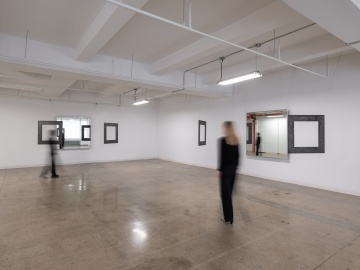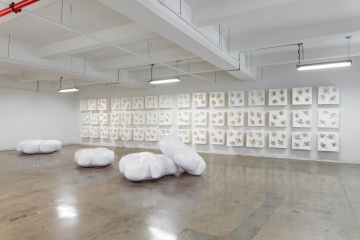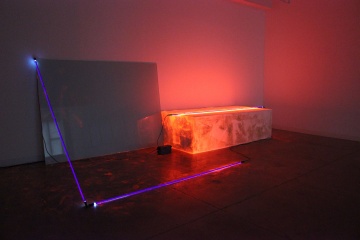Castelli Gallery
18 East 77th Street, 3rd Floor
New York, NY 10075
212 249 4470
Also at:
24 West 40th Street
New York, NY 10018
212 249 4470
New York, NY 10075
212 249 4470
Also at:
24 West 40th Street
New York, NY 10018
212 249 4470
Works Available By:
Noriko Ambe
Noriko Ambe
Arakawa
Richard Artschwager
Hanne Darboven
Dan Flavin
Jasper Johns
Diana Kingsley
Joseph Kosuth
Roy Lichtenstein
Robert Morris
Bruce Nauman
Claes Oldenburg
Richard Pettibone
Robert Rauschenberg
Edward Ruscha
Keith Sonnier
Mike and Doug Starn
Frank Stella
Cy Twombly
Andy Warhol
Lawrence Weiner
Robert Morris
Robert Morris: Seeing and Space
September 2, 2025 - October 31, 2025
Castelli Gallery is pleased to present Robert Morris: Seeing and Space. The exhibition juxtaposes two
forms of work dating from the 1970s: Untitled (Walk Around), 1975, a mirror installation; and a group of
eight Blind Time drawings dating from 1973 and 1976.
Robert Morris was a pioneer of Minimal art. His minimalist sculpture of the 1960s consisted of abstract
objects in plywood, fiberglass, aluminum, and steel. Sitting directly on the floor, these works are blank in
affect and large enough to establish a one-to-one physical encounter with the observer.
During the early 1970s the artist’s practice changed direction. One new tendency was the production of
objects and installations that can be occupied and walked through. New work took various forms,
including installations with mirrors. Here the virtual space of mirror reflection appears to alter or
complicate the actual space of the room. Untitled (Walk Around) was the first installation of this kind. It
consists of mirrors and flat, empty steel frames arranged to create a sequence of vantages, including
positions from which the frames appear—through reflection—to multiply endlessly, a virtual impression
of infinite regress.
Beginning in 1973 Morris also embarked on a long series of drawings titled Blind Time. The drawings
were produced by the artist with his eyes shut, a bare-handed application of powdered graphite and other
mediums directly onto sheets of paper large enough to contain the breadth of his reach. Each drawing
follows a set of instructions, or “protocols,” executed according to an estimated length of time.
Together the mirror installations and the Blind Time drawings represent opposing extremes of embodied
vision: seeing multiplied and seeing obscured.
Robert Morris: Seeing and Space, is organized by curator and critic Jeffrey Weiss, who has worked
extensively on the artist. His past projects include (with Clare Davies) the book Robert Morris: Object
Sculpture, 1960-1965, published by Castelli Gallery in partnership with Yale University Press, and Robert
Morris: The Perceiving Body, an exhibition that appeared at the Museum of Modern Art (MUDAM),
Luxembourg.
Robert Morris
Robert Morris: Seeing and Space
April 3, 2025 - June 27, 2025
Castelli Gallery is pleased to present Robert Morris: Seeing and Space. The exhibition juxtaposes two
forms of work dating from the 1970s: Untitled (Walk Around), 1975, a mirror installation; and a group of
eight Blind Time drawings dating from 1973 and 1976.
Robert Morris was a pioneer of Minimal art. His minimalist sculpture of the 1960s consisted of abstract
objects in plywood, fiberglass, aluminum, and steel. Sitting directly on the floor, these works are blank in
affect and large enough to establish a one-to-one physical encounter with the observer.
During the early 1970s the artist’s practice changed direction. One new tendency was the production of
objects and installations that can be occupied and walked through. New work took various forms,
including installations with mirrors. Here the virtual space of mirror reflection appears to alter or
complicate the actual space of the room. Untitled (Walk Around) was the first installation of this kind. It
consists of mirrors and flat, empty steel frames arranged to create a sequence of vantages, including
positions from which the frames appear—through reflection—to multiply endlessly, a virtual impression
of infinite regress.
Beginning in 1973 Morris also embarked on a long series of drawings titled Blind Time. The drawings
were produced by the artist with his eyes shut, a bare-handed application of powdered graphite and other
mediums directly onto sheets of paper large enough to contain the breadth of his reach. Each drawing
follows a set of instructions, or “protocols,” executed according to an estimated length of time.
Together the mirror installations and the Blind Time drawings represent opposing extremes of embodied
vision: seeing multiplied and seeing obscured.
Robert Morris: Seeing and Space, is organized by curator and critic Jeffrey Weiss, who has worked
extensively on the artist. His past projects include (with Clare Davies) the book Robert Morris: Object
Sculpture, 1960-1965, published by Castelli Gallery in partnership with Yale University Press, and Robert
Morris: The Perceiving Body, an exhibition that appeared at the Museum of Modern Art (MUDAM),
Luxembourg.
Noriko Ambe
Noriko Ambe: State of Flow, Andy Warhol "Flowers", Leo Castelli, 1964
November 12, 2024 - January 17, 2025
Sixty years ago, Andy Warhol opened his first exhibition at Leo Castelli at 4 East 77th Street. Titled Andy Warhol. Flower Paintings, the exhibition presented a wall in which twenty-eight small paintings were displayed very close together in a 4 x 7-foot grid. The flower petals ranged in color and were a stark contrast against the grey grass in the foreground.
In 2020, artist Massimo Barzagli wrote about the exhibition and noted that it was not a coincidence that Warhol chose to present the exhibition in 1964, “The Vietnam War is in full swing and many young people, who had left for service in the mid 1950s are returning home as martyrs.” Flowers can be both decorative and commemorative, and while at first glance Warhol’s exhibition may appear as just a simple pleasantry, one can also look at it as a memorial for the young Americans who lost their lives in Vietnam.
The exhibition signaled the beginning of a long collaboration between Andy Warhol and Leo Castelli. To remember it, Castelli Gallery invited artist Noriko Ambe to reflect on the show and create a response to the exhibition on its sixty-year anniversary.
Using black and white images from the gallery’s archive as a reference, Ambe reproduced the original canvases in four different ways. The depths of color are depicted in varying shades of grey in the archival photography and to symbolize this, Ambe layered sheets of Yupo paper of varying thickness. Each sheet of Yupo paper is intricately cut to express the way the shape of the flower is inverted as hollow. This ultimately transforms the shape of the flowers, which repeat like mirror images, into a void-like presence. Therefore, Warhol’s lively colors are replaced by emptiness and white, repeating the message of beauty in flowers and a sense of loss.
Additionally, the artist created three cutting and pasting books and was largely influenced by the political environment at the time of the 1964 show. As Ambe states, “I thought about historical perspectives and aimed to create an exhibition with a multi-layered interpretation in a contemporary context by expressing this complexity through the medium of paper cutting and books.”
Keith Sonnier
Keith Sonnier: Drawings
September 17, 2024 - October 25, 2024
Keith Sonnier was a prolific draftsman. Drawing was the foundation of his art, the mainstay of his mercurial and diverse creativity. Keith Sonnier: Drawings focuses on a selection of drawings made between 1966 and 1970, the earliest of which are from the artist’s time as an MFA student at Rutgers University.
Many of the ephemeral and inflatable works in Sonnier’s thesis exhibition are easily recognizable as three-dimensional forms in these preliminary drawings, collectively titled the Early Rutgers and File Series, both from 1966. Unusually formal, precise even in their execution and composition, they are remarkable in that they are among only a few of his drawings to utilize perspective.
Sonnier alternated between significantly different series of work which is reflected in his drawings. Freehand line drawings articulated the form and the materials such as transformers, wires, silver tipped light bulbs in the earliest light works like Neon Wrapping Lightbulbs, circa 1967. The organic loops and undulating lines in the drawings, which are made with markers on plain paper or ballpoint pen on red graph notepads, were translated into flexible copper (with dimensions similar to those of neon tubes) thus making perfect templates, providing the sculptor with full-size maquettes, and the neon fabricator with three-dimensional “drawings in space” to work from.
Plain, loose-leaf sketch pads, or notebooks with graph paper, provided a framework for the straight lines, circles and squares seen in Sonnier’s glass and neon work that began in his Mulberry Street Studio such as Ba-O-Ba and Early Glass and Neon. The free-form neon loops and low-tech materials of the Neon Wrapping Lightbulbs series were replaced by the rigid geometry of the Ba-O-Ba’s, 1969-2019. This major series of work may have begun with thumbnail sketches but over the course of fifty years evolved in both scale and concept to include sculptures and architectural installations whose symmetry and proportions were inspired by the concept of the golden ratio and sacred geometry.
During the early 70’s, Sonnier switched gears completely, moving away from sculpture and instead immersing himself in the possibilities offered by the latest technology. This investigation took his work in new directions for almost a decade. The drawings that bring this exhibition to a close relate specifically to the experimental film and video work documented in the Castelli Sonnabend Videotapes and Films, 1974. Sketches and drawings such as the Electrical Cut Studies, 1970, focus on the positioning of video equipment and the manipulation of video editing techniques.
Keith Sonnier was born in 1941 in Mamou, Louisiana. He had his first solo show at Castelli Gallery in 1970. He died in Southampton, New York in 2020. This November, Dia will open Keith Sonnier, a long-term presentation which includes works from the 60s and 70s.
Joseph Kosuth, Keith Sonnier
Joseph Kosuth / Keith Sonnier
June 10, 2024 - July 18, 2024
Castelli Gallery, 24 West 40th Street, is pleased to present Joseph Kosuth / Keith Sonnier, an exhibition that brings together the work of two artists who have been associated with Castelli Gallery since the beginning of their careers.
Joseph Kosuth’s ‘Titled (A.A.I.A.I.)’ [Exterior-Interior] (Ety.), 1967, is an example of the artist’s “definition” works that are based on borrowed language. The work is made up of seven mounted photographs and is the only seven-part work that the artist made from this series. In this work, Kosuth goes a step further by using an etymological dictionary, which further exemplifies the iconic idea of language borrowed from dictionaries.
Perhaps the most “conceptual” part of the work is the notion of when the work is dated, or rather how it should be dated. Kosuth’s work is largely dated at the date of conception, in this case, 1967; yet it was not fabricated until decades later. In this way, it is difficult to answer the question if the work is “original.” Similarly to ‘Titled (A.A.I.A.I.)’ [Exterior-Interior] (Ety.), Kosuth’s R.M. #1, 1992, is composed of a rectangular piece of glass lying on an aluminum shelf and 1992; however, the original sheet of glass from 1992 is not required when exhibiting the work, but rather can be fabricated at any time. The text displayed on the glass relates to the relationship between art and language with the viewer.
While Joseph Kosuth’s works focus on language, Keith Sonnier’s Ba-O-Ba Fluorescent, 1970, is largely ephemeral. Composed of foam, neon light with fluorescent powder, and glass, the work was included in the artist’s first solo exhibition at Castelli Gallery in 1970 at Castelli Warehouse. Ba-O-Ba Fluorescent is an example of Sonnier rejecting traditional mediums for sculpture such as bronze and marble in favor of materials that are psychologically loaded, like reflective glass and foam. Both ‘Titled (A.A.I.A.I)’ [Exterior-Interior] (Ety.), R.M. #1, and Ba-O-Ba Fluorescent, comment on the idea of what is an original artwork and defy the traditional ideas of fine arts.
Joseph Kosuth was born in in Toledo, Ohio in 1945. He lives in New York and Venice, Italy.
Keith Sonnier was born in Mamou, Louisiana in 1941 and passed away in Southampton, New York in 2020. His upcoming long-term presentation, Keith Sonnier, opens at Dia Beacon in November 2024.
James Rosenquist
James Rosenquist: The Holy Roman Empire through Checkpoint Charlie
January 16, 2024 - May 24, 2024
Castelli Gallery is pleased to present James Rosenquist, The Holy Roman Empire through Checkpoint Charlie. Nearly forty feet long, Rosenquist’s painting The Holy Roman Empire through Checkpoint Charlie, 1994, encompasses his commentary on both history and politics. This monumental work was first exhibited at Leo Castelli Gallery in October 1994.
Rosenquist was galvanized by his visit to Berlin after the fall of the Berlin Wall in 1989, and following his return home he began to work on this singular painting. He was largely affected by the difference he saw between the East and the West, and particularly struck by the barren wasteland in East Berlin. Especially compelling to him was his encounter with the historical crossing point of the Berlin Wall known as Checkpoint Charlie.
The center of the painting is dominated by a large and intense red eye. While it is impossible to know what the eye stands for, after consulting sources made available from the archive of the artist, it may symbolize the relation to the Russian occupation zone in East Germany at the end of War World II.
In the left area of the painting is a sizable image of a what at first glance looks like a knight on a horse, moving triumphantly, and partially disappearing through a landscape of trees. In reality, this image depicts King Frederick the Great, under whose leadership Prussia became one of the greatest states in world history. The image is taken from the Daniel Rauch sculpture Equestrian Statue of Frederick the Great, 1851, located on the Unter den Linden, named for linden, or lime trees, the avenue in Berlin which was the main focal point of social and cultural life before World War II.
On the right side of the painting, Rosenquist has drawn the figures from Nike Instructs the Boy in Heroic History, Emil Wolff’s 1847 sculpture located on the Schloßrücke, a bridge in the central Mitte district of Berlin. Nike, the Greek goddess of victory, is showing the young boy the names of the “Great” victorious generals of the past: Alexander III, Julius Caesar, and Frederick II. While it is an edifying image, one is struck by the artist’s decision to depict Nike’s wings on fire, alluding to the tragedy these conquerors brought with them. Rosenquist’s mounting of a burnt piece of wood onto the canvas creates a dichotomy between the pretend, painted fire and the actual object destroyed by it.
On the right edge of the canvas is a column taken from the Brandenburg Gate, originally commissioned by Frederick the Great in the 1700s. Surprisingly, Rosenquist breaks from the linear composition of the canvas and instead shapes the bottom of the canvas to simulate the shape of the column’s pedestal, which gives the impression of being in front of the actual column and looking at it from below. This reference to the Brandenburg Gate symbolizes the division between East and West, or perhaps as a sign of future accord.
Rosenquist breaks away from traditional painting by adding an actual object, a small-scale ladder, which leans against the painted column. The size of the ladder exemplifies Rosenquist’s use of perspective as it is minute in comparison to the column and the immense size of the artwork. It is indeed the size that makes us see the ladder as unreal, an allegory for crossing from East to West or even actually attempting it, should one have acquired the tools to do so. The ladder portrays a final moment of negativity seen throughout the artwork, yet also suggests there may be a small glimmer of hope.

 Back to all Member Galleries
Back to all Member Galleries





